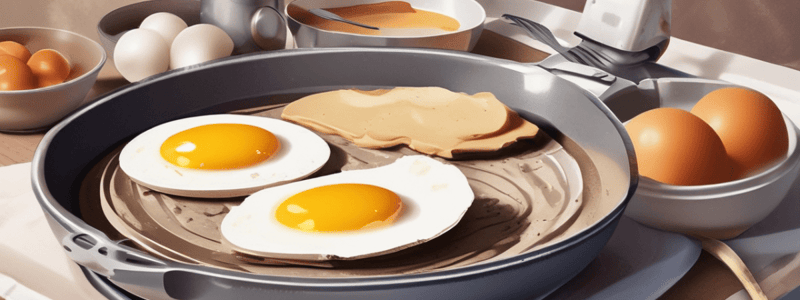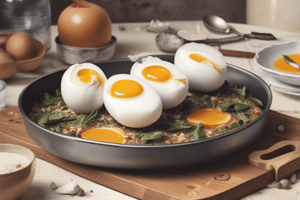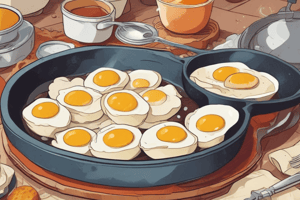Podcast
Questions and Answers
What is the recommended cooking time for a jammy egg if the eggs are straight from the fridge?
What is the recommended cooking time for a jammy egg if the eggs are straight from the fridge?
- 7 minutes
- 10 minutes
- 9 minutes (correct)
- 12 minutes
Soft-boiled eggs are peeled similarly to hard-boiled eggs.
Soft-boiled eggs are peeled similarly to hard-boiled eggs.
False (B)
What is the purpose of transferring the eggs to an ice water bath after boiling?
What is the purpose of transferring the eggs to an ice water bath after boiling?
To stop the cooking process
For Technique A, the eggs are simmered for _______________ minutes if they are at room temperature.
For Technique A, the eggs are simmered for _______________ minutes if they are at room temperature.
Match the following boiling techniques with their corresponding cooking times:
Match the following boiling techniques with their corresponding cooking times:
What is the recommended method to serve soft-boiled eggs?
What is the recommended method to serve soft-boiled eggs?
Why is it challenging to achieve the perfect jammy egg?
Why is it challenging to achieve the perfect jammy egg?
Jammy eggs are typically peeling like hard-boiled eggs.
Jammy eggs are typically peeling like hard-boiled eggs.
What is the simplest way to cook an egg?
What is the simplest way to cook an egg?
The water needs to be at a rolling boil to cook eggs.
The water needs to be at a rolling boil to cook eggs.
How long does it take to cook a soft-boiled egg?
How long does it take to cook a soft-boiled egg?
The egg white needs to be kept __________ if it's going to be consumed directly from the shell.
The egg white needs to be kept __________ if it's going to be consumed directly from the shell.
Match the following cooking techniques with their descriptions:
Match the following cooking techniques with their descriptions:
What is the term used to describe a soft-boiled egg that has been cooked for 3 minutes?
What is the term used to describe a soft-boiled egg that has been cooked for 3 minutes?
Eggs can be cooked in water at a rolling boil.
Eggs can be cooked in water at a rolling boil.
What is the purpose of lowering the water to a simmer after adding the eggs?
What is the purpose of lowering the water to a simmer after adding the eggs?
How long does it take to hard boil a large egg?
How long does it take to hard boil a large egg?
It is recommended to stack the eggs in the pot when hard boiling.
It is recommended to stack the eggs in the pot when hard boiling.
What is the purpose of adding vinegar to the water when hard boiling eggs?
What is the purpose of adding vinegar to the water when hard boiling eggs?
The pot should be covered with cold water, at least ______ inch above the eggs.
The pot should be covered with cold water, at least ______ inch above the eggs.
What happens if the eggs heat too quickly during the hard boiling process?
What happens if the eggs heat too quickly during the hard boiling process?
It is recommended to bring the pot to a boil with a lid.
It is recommended to bring the pot to a boil with a lid.
Match the following egg sizes with their corresponding hard boiling times:
Match the following egg sizes with their corresponding hard boiling times:
What should you do to create a whirlpool in the pot?
What should you do to create a whirlpool in the pot?
Poached eggs can be added to soups and stews.
Poached eggs can be added to soups and stews.
What seasonings pair well with poached eggs?
What seasonings pair well with poached eggs?
After poaching an egg, place it onto _______________________ to drain excess water.
After poaching an egg, place it onto _______________________ to drain excess water.
Match the following ways to serve poached eggs with their descriptions:
Match the following ways to serve poached eggs with their descriptions:
What should you use to trim loose bits of egg white?
What should you use to trim loose bits of egg white?
What is the primary difference between poached eggs and hard-boiled eggs?
What is the primary difference between poached eggs and hard-boiled eggs?
Poached eggs can have a varying degree of doneness.
Poached eggs can have a varying degree of doneness.
What is the purpose of adding vinegar to the poaching water?
What is the purpose of adding vinegar to the poaching water?
The ovalbumin protein in egg whites solidifies when heated due to the process of ____________________.
The ovalbumin protein in egg whites solidifies when heated due to the process of ____________________.
What should you do to the egg before poaching it?
What should you do to the egg before poaching it?
It is recommended to bring the pot to a boil with a lid when hard boiling eggs.
It is recommended to bring the pot to a boil with a lid when hard boiling eggs.
Match the following components of an egg with their descriptions:
Match the following components of an egg with their descriptions:
To poach an egg, you should add a teaspoon of ____________________ to the water.
To poach an egg, you should add a teaspoon of ____________________ to the water.
Flashcards are hidden until you start studying
Study Notes
Boiling Eggs
- Immersing an egg in boiling water is the simplest way to cook it.
- Eggs cooked whole require mild heat to preserve whites soft and yolks moist.
- The process of cooking eggs in water without breaking their shells is known as boiling.
- The water needs to be at a simmer to prevent toughening the whites.
Soft Boiled Eggs
- A soft-boiled egg is a whole egg that has been simmered in water until the white is set but still soft and the yolk is still runny inside.
- It takes 3 to 4 minutes to cook, depending on the desired level of doneness.
- The white needs to be kept soft if it's going to be consumed directly from the shell.
Cooking Soft Boiled Eggs
- Bring water to a slow boil, then lower it to a simmer.
- Gently place the eggs in the water, and cook for 3 to 4 minutes.
- Remove with a slotted spoon, transfer to a colander, and cool under cold running water to stop the cooking.
Peeling Soft Boiled Eggs
- Soft boiled eggs aren't peeled like hard boiled eggs due to their liquidy yolk and soft white.
- Serve by slicing off the top of the shell and serving in an egg cup.
Jammy Eggs
- A jammy or medium boiled egg is one that has more stability than a soft boiled egg but isn't as firm as a hard boiled egg.
- It is generally boiled for 7-9 minutes to achieve the perfect jammy texture.
Cooking Jammy Eggs
- Bring water to a rapid boil, then lower the heat to maintain a simmer.
- Cook for 7 minutes, or 9 minutes if eggs are straight from the fridge.
- Remove eggs from boiling water and plunge them into an ice bath.
Peeling Jammy Eggs
- Jammy eggs may be peeled and served without the entire shell.
- They can also be served like soft boiled eggs, with just the top cut off in an egg cup.
Hard Boiled Eggs
- Hard-boiled eggs are a delicious snack or addition to salads, sandwiches, and wraps.
- Precise timing is required to produce a hard-boiled egg without cracks or ugly green yolks.
- The size of the egg plays a huge factor in how long it takes to hard boil an egg.
Cooking Hard Boiled Eggs
- Place eggs in a single layer on the bottom of the pot, and cover them with cold water.
- Bring the pot to a rolling boil, then remove it from the heat.
- Let the eggs sit for 12-15 minutes, depending on their size.
Peeling Hard Boiled Eggs
- Hard-boiled eggs can be peeled and served without the entire shell.
Poaching Eggs
- Poached eggs follow the same principles as hard-boiled eggs, except the shell is not present.
- The goal is to maintain the egg's shape, which is compact and circular, not spread out over the entire pan.
- A poached egg is one that has been simmered in acidic boiling water without its shell.
- Timing is key when poaching an egg, and it's easier to check for doneness compared to boiling eggs.
- Poached eggs can be overcooked or undercooked, but not have varying degrees of doneness.
- The ideal poached egg is compact, round, with firm but tender whites and warm, liquid yolks.
Chemistry of Egg Whites
- Egg whites are primarily composed of ovalbumin protein and a small amount of water.
- Ovalbumin solidifies when heated due to denaturation, causing the protein to break down and start to solidify.
- Denaturation can be done in different ways, including adding an acid to the cooking process.
- Adding vinegar to the boiling water speeds up the process of denaturing, helping the poached egg maintain its shape better.
Cooking Poached Eggs
- Fill a large, nonstick pot with water, adding a teaspoon of vinegar or lemon juice and a handful of kosher salt if using.
- Bring the water to a simmer, then crack a fresh egg into a fine strainer, and tip it into a cup, small bowl, or ramekin.
- Swirl the water to create a small whirlpool, then gently tip the egg into the pot.
- Leave the water to simmer for 3-4 minutes or until the white is firm but still tender and the yolk feels semi-liquid.
- Carefully lift the egg using a slotted spoon, allowing excess water to drain off, and place it onto kitchen paper to drain remaining water.
Serving Poached Eggs
- Popular ways to eat poached eggs include simple or on toast with butter.
- Salt and pepper make great seasonings, and poached eggs can be added to soups, stews, salads, and more for a protein-rich addition.
- Serve poached eggs with melted butter and freshly chopped herbs for a more elegant presentation.
Studying That Suits You
Use AI to generate personalized quizzes and flashcards to suit your learning preferences.




